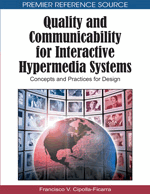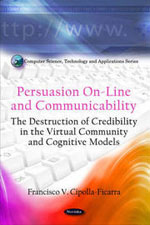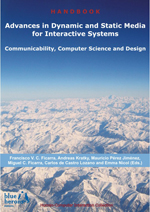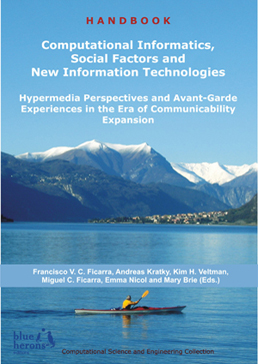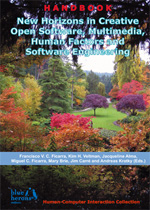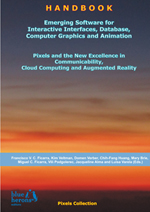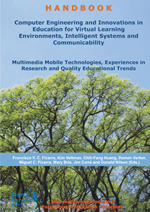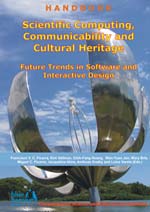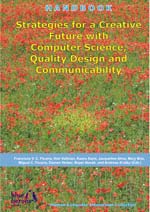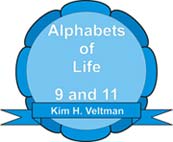Emerging Software for Interactive Interfaces, Database, Computer Graphics and Animation: Pixels and the New Excellence in Communicability, Cloud Computing and Augmented Reality
:: Pixels Collection ::
:: Revised Selected Chapters ::
Main Editor: Francisco V. C. Ficarra
Co-editors: Kim H. Veltman (Maastricht, The Netherlands), Domen Verber (Maribor, Slovenia), Chih-Fang Huang (Taiwan, China), Mary Brie (La Valetta, Malta), Miguel C. Ficarra (Italy and Spain), Vili Podgolerec (Maribor, Slovenia), Jacqueline Alma (Vancouver, Canada), and Luisa Varela (Perpignan, France)
Editorial Assistant: Donald Nilson (Oslo, Norway)
Book Details
• ISBN: 978-88-96471-19-7 :: DOI: 10.978.8896471/197
• Publisher: Blue Herons Editions
• Location: Italy (Bg)
• Subjects: Augmented Reality, Computer Animation, CAD, Laser Scans, Cultural Heritage
• Subjects: Games, New Technologies, Social Networks, Virtual Reality, Web GIS, Interface
• Subjects: Multimedia, Semantic Database, Music Emotion Model, Human-Centered Design
• Subjects: Interactive Multimodal Environment, 3D, Green Retrofit, AI, Computer Graphics
• Subjects: Virtual Reconstruction, Heuristic Evaluation, Global Navigation Satellite System
• Subjects: Real-time Strategy, Semantic Database, Mobile Applications, Design, Education
• Copyright: 2012
• Collection: Pixels
• Series volume: I
• Publication date: December, 2012
• Binding: Paperback
• Grade level: General
• Language: English
• Illustrations: Yes
• Colour: Yes
• Pages: 159
• Dimensions: 11.41x8.26x0.43 in. 1.13 lbs. :: 290x210x11 mm. 516 gr.
Preface
What is essential, is invisible to the eye –The Little Prince.
Antoine de Saint-Exupéry (1900 – 1940)
Computer generated images have always drawn the attention of millions of people in their different roles: students, professors, researchers, designers, movie directors, etc. It is not only the magic of generating synthetic, static and/or dynamic images, emulations or simulations of reality, but of capturing all the creative abilities of the human being to narrate events, from the memory of the past, descriptions of current reality and projections towards the future. In other words, they may be timeless images and malleable towards the infinite.
In them rests the freedom of expression in a chromatic and three-dimensional way where sometimes it is difficult to see whether we are in the face of something real or virtual. It is the charm of the viewing power of communication where an image is always worth more than a thousand words. Not for nothing when the first graphics appeared to depict the numerical information in the offices, it marked the beginning of the use of computers in the businesses with professional purposes until they reached the home. It was these synthetic images which collaborated to change the meaning of the PC initials, that is, from professional computer to personal computer.
The risk lies in the fact that those who manage those images respect the final viewer, at the moment they are presented to his/her eyes. That is, a transparent communication avoiding manipulation through them. If this doesn’t happen, the written word takes again a prevailing place in the communicative process, and one goes back to the time of the appearance of print. It is in this regressive period where the human and social factors may be inserted, which generate different types of structures which do not change over time.
Although we are in one of the most dynamic sectors of the current interactive systems, we may come across in some places of the Old Continent with dogmas and their supporters, who slow down the whole creative process which entails working with these computer-made images. Now if the human and social factors are positive, in view of the constant advances of the graphic hardware and software, the only limit that exists is the imagination or originality at the moment of generating static and/or dynamic images in 2D and 3D.
Computer graphics and computer animation along with text, audio and video have been key in the momentum of the Internet phenomenon of the 20th century. In the new millennium they have been the main means of drawing the attention of the users to the screens of a great variety of devices of classical computing.
There are millions of users who decide to purchase computer equipment because of the images that they can see on the screens. These images gain in quality thanks to their generation from scratch and thanks also to myriad techniques, methods, algorithms, etc. related to computer graphics down to the access to the information stored in the database, such as decompressed files with multimedia information available via the interaction of the user through the various peripherals.
Virtual images are generated in 2D and/or 3D, thanks to democratization of the pixels in 1990 – 2000. Users are now capable of generating images in movement for 3D starting from photographs with digital cameras or the commercial applications to generate films with computer animations.
In this whole productive process, whether it is at a personal or an industrial level the cost factor is always present, in the equation of maximum quality in the least possible time. To reach that goal it is necessary to resort to several quality attributes that have an influence from the design stage right until the programming of the applications used in the context of graphic informatics.
Our intention in the current handbook is to show an essential part of those strategies and also the latest breakthroughs in all that which is directly or indirectly related to computer graphics, computer animation, database, software quality, hypermedia, design, communicability, interfaces, cloud computing, augmented reality, human-computer interaction, computer-aided design, mixed reality, models, techniques and methods of computer science, etc.
Some of the works that make up the current compendium have been presented orally by their authors in the following international conference in Venice, Italy: SETECEC 2012 –First International Conference on Software and Emerging Technologies for Education, Culture, Entertainment, and Commerce: New Directions in Multimedia Mobile Computing, Social Networks, Human-Computer Interaction and Communicability, and international symposium in Valle d'Aosta, Italy: CCGIDIS 2012 –Second International Symposium on Communicability, Computer Graphics and Innovative Design for Interactive Systems.
The innovation and originality of those proposals has been the reason for which the authors have been invited to enlarge their works submitting again the new versions to an assessment process of said works by the members of the scientific committee. Consequently, these are works that have gone satisfactorily through a double process of international selection. In the next section a short introductory presentation of the research works that make up the current compendium is given:
The authors Luigi Barazzetti and Marco Scaioni present an interesting work “Transforming Images and Laser Scans into 3D Models” where theory and practice converge in the context of 3D images. They introduce all details of the use of a laser scanner to obtain high quality three-dimensional images and accuracy in the maintenance and the virtual reconstruction of cultural heritage, for instance. Besides, they comprehensively describe computer vision and photogrammetric 3D modeling techniques that are mainly based on images or laser scans. The description further covers the integration of global navigation satellite system (GNSS) or theodolite data allowing precise geo-referencing. The main goal they have set themselves is to indicate the reliability and robustness of their combined use for real surveys. Simultaneously a set of real examples serves to illustrate each one of the advantages and disadvantages of the used methods and techniques. In these examples the resolution of complex problems and with reduced costs can be verified. Each one of the issues is approached in a didactic way which facilitates the understanding even of the diverse devices used for the measurements.
Chih-Fang Huang, Chih-Hsiang Liang, and En-Ju Lin are the authors of the chapter “Sound-Color Synaesthetic Effect Using Algorithmic Composition with Image for Emotional Release.” In said research they present the qualities of music from an emotive point of view. This is one of the motivations why they spread their study to the field of colors. In this sense, they develop an emotional model for music based on studies of color theory. Another main goal is to present the emotions of the users of a special software starting from the color and the electronic sounds that these represent from the psychological point of view, an approach informed by studies belonging to the set of the music color synesthesis and emotion releasing effect. Throughout the research work the authors explain in a gradual, simple and thorough way each one of the presented concepts with their matching theoretical examples and also the use of a special software for the experiments they have carried out.
The research work “User-created Interior Design Service Concepts, Interfaces and Outlines for Augmented Reality” has been made by the following authors Tiina Kymäläinen and Sanni Siltanen. This research work presents us masterfully a design process and the implementation requirements of an interactive interior design system. In said system the use of two focus groups can be detected where the knowledge and the experiences of designers, bloggers and serious amateurs in the field of interior design interact transversally. In that transversal interaction of diverse professionals the presence of user-driven innovation can be seen. The strategies of the conformation of the professionals and the transversal knowledge to the different areas of knowledge are explained with examples. Examples are given, which describe all the aspects of the new technologies applied to augmented reality, the results of tests with real users, the realization of a special software for the three-dimensional visualization of interiors, etc. Each one of the stages of the research project is accompanied by its corresponding textual and graphical explanations. Finally the authors make a wide-ranging reflection about the learned lessons signaling the positive and negative aspects of the used technology and also the future lines of research before their conclusions.
In the context of artificial intelligence, Damijan Novak and Domen Verber show us in their research “New Generation of Artificial Intelligence for Real-time Strategy Games” the importance of applying it to computer games. The text starts with a complete state of the art overview, where the main notions to which the current research work refers are defined. In it is a constant interrelation among real-time strategy, games and artificial intelligence. The authors signal the importance of these issues within the academic field since they have detected new fields for research, whether in the present or the immediate future. Besides, in this work an excellent comparison example in the open-source real time strategy game development tools can be seen. The main and secondary goals of the text are gradually developed answering to a set of rhetorical questions with practical examples. All of this makes the reading and understanding easier to the potential readers. Their proposal of an enhanced combat artificial intelligence algorithm is striking in a very positive way.
The authors of the chapter “Towards Smart Mobile System for Public Bus Transportation” are Mitja Krajnc, Vili Podgorelec, and Marjan Heričko. In it converge the use of multimedia mobile phones and the geographical information systems (GPS satellite) for the localization of public buses in the town of Maribor, Slovenia. The system allows the user to see the movement of the buses in the road network through a real-time visualization on a mobile phone. The digital information which replaces the analogical one such as the timetables of the buses on paper support increases the available options of those users to access the public transportation system such as the combination of buses to reach a given destination. Besides, ease of use of the system can be seen since it is based on Windows Phone. Finally a quality attribute of the interactive systems such as the prediction has been incorporated to the system. The goal pursued by its authors is to increase the alternatives the user has at the moment of accessing the interactive information without this having negative repercussions on the visualization of the information inside the interface of the mobile phone.
Under the title “A Learning Environment based on Movement and Sound Interaction” its authors Serena Zanolla, Sergio Canazza, Antonio Rodà, Giovanni De Poli, and Gian Luca Foresti present an Interactive Multimodal Environment for E-learning called “Stanza Logo-Motoria.” The experiments carried out with children for the learning of a second language such as English have allowed the authors to carry out several experiments with positive results. A special module has been developed and tested in this sense called English as a Second Language (ESL). The motivation for learning languages in an environment of these characteristics is presented in a detailed way with a special stress on other aspects such as the socialization of early age users through new interactive technologies. Along with this the authors introduce technological aspects of interactive design which have been evolving as the experiments were carried out.
Michele Argiolas, Claudia Loggia, Vittorio Tramontin, and Cristina Trois are the authors of the chapter called “A Web Application to Support Decision Making Process Based on a Bottom-up Approach in Public Buildings’ Green Retrofit.” They introduce a GIS web application related to such topics as green retrofit, public buildings, cost management just to mention three examples. The proposal starts with a comprehensive state of the art in legislation issues as technique of the main and secondary topics approached by its authors. The work shows how the implemented system online may serve to curtail the costs of management of green retrofitting public buildings. The study shows a constant interrelation among several disciplines of the sciences. Each of the issues is very well referenced in the bibliography section and they are developed in a pleasant way for the reader non-specialized in the issues approached at the start. Besides, there is a comparative study of real cases which entail additional advantages to the work developed by each one of the authors of the current text. Finally we can state that we are in front of an excellent triadic example of interrelations among databases, access to the stored information and the management of public administration.
The wide range of the phenomenon of the social networks requires in many of the offered services a set of recommendations. In this sense the authors Sašo Karakatič, Vili Podgorelec, and Marjan Heričko show in their research work “Merging Social Networks and Semantic Databases to Build Recommendation Service” the potential of linking semantic databases and social networks. Starting from Facebook and Freebase they have fashioned a prototype that uses Java technology. The prototype takes into consideration each one of the key elements for the recommendation of an online service to the potential users of contents in TV format, videogames, music, etc. In this sense we see a novel low cost solution is little by little brought forward by the authors along the pages. Besides, they have made a series of tests with users at the moment of interacting with the software and the hardware used. The results obtained back up the transcendence of the current proposal, and also the future developments they will make in a short time.
The three-dimensional reconstruction of the religious-historical heritage in the province of Avila (Spain) is the main objective of “Computer Graphics to Encourage the Participation in the Virtual Reconstruction of Cultural Heritage: The Example of the Monastery of Nuestra Señora del Risco” author of the chapter whose title is Gonzalo Martín Sánchez. Starting from a reality which reveals the passing of time and the scarce remains of the walls of the monastery, the author resorts to several techniques using static images in 2D and 3D, such as historical cartography, digital photography, commercial software and open source, etc., for three-dimensional reconstruction. Now the author points out that these techniques from the field of computer graphics must be accompanied by a previous historical study of that is intended to be rebuilt. In this sense the illustrations, as well as the used methodology can serve as a guide for other analogous works.
In “Developing Design Guidelines for E-Learning Environments: A War Story” its authors Laura Benvenuti, Maria Menendez Blanco, and Gerrit C. van der Veer, denote the importance of the design, development, evaluation of a system oriented at university e-learning. A comprehensive study of the educational system to be developed with Moodle highlights the intersection between pedagogical theory, interactive design computer programming, among other areas of knowledge when it refers to blended academic education. A course on webculture has allowed the authors to carry out analyses of the web design. The university students belonging to the social sciences (culture, psychology, etc.) have taken part in several processes of heuristic evaluation to reach the goals proposed by the authors of the current research work. The learned lessons, future lines of research and the conclusions are interesting sections to understand the acquired experiences and for new research in the context of the blended education, distance learning, Internet based learning environments to mention a few examples.
The author presents a heuristic study of the evolution of human factors with their educational and social consequences in the context of the pixel of Southern Europe during the years 1990 – 2012, under the title “Pixels: Educational Structures and Power Systems.” Simultaneously, it is used for the first time a special language where diachronism interacts with the synchronism of the real examples that are presented, related to the graphics software. Besides, in this first research work are combined different techniques of the social sciences to establish the nodes and links which make up the human and functional structure of all that related to the commercial and educational pixel. Lastly, a series of strategies is put forward to analyse the educational quality of some training centers with regard to computer graphics and its derivations.
Francisco V. C. Ficarra
Tenerife, Spain (December 2012)
Partial Content On-line (pdf format)
• Front Cover (here)
• Preface :: Acknowledgment (here)
• Chapters :: Final Remarks :: Author Index :: Keywords Index :: References ... (here)
• Back Cover (here)
Additonal Handook Info
• Only paper copy – no digital book on-line and/or off-line –
• Special Price € 95 (expedition cost not included) ... e-Commerce :: Info Form
Welcome to Blue Herons Editions!
The origin of this publishing project is to be found in the Canadian lands, where nature presents itself generous in many places of its wide geography. More...
Education, Communicability, Design, Computer Science, HCI, Computer Graphics and Computer Animation:
We focus on education and new technologies with 32 years long experience. More...
Literature and Journalism:
Intersection between universal literature, local new journalism (true stories), sociology and legal immunity. Two collections:
- Casoncelli Bergamaschi
It is a typical bergamasque dough filled with meat, similar to the raviolis. More...
- Menjar Blanc & Black
It is a typical sweet of the Catalan coast and the Balearic Islands. More...
Others New Releases:
See all others new releases in books, CD, DVD, etc. More ...
Call for Papers: ADNTIIC 2015 :: HCITOCH 2015 :: SETECEC 2015 :: HIASCIT 2016 :: CCGIDIS 2015 :: IPCTIIC 2015 | HCITISI 2015 :: MSIVISM 2016 :: RDINIDR 2015

